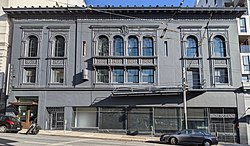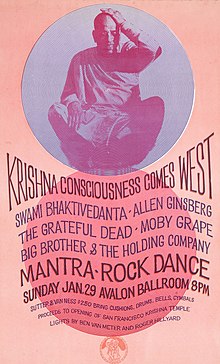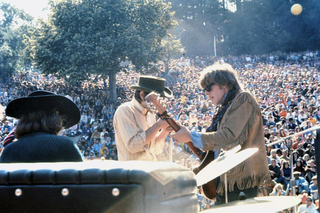
The Summer of Love was a social phenomenon that occurred during the summer of 1967, when as many as 100,000 people, mostly young people sporting hippie fashions of dress and behavior, converged in San Francisco's neighborhood of Haight-Ashbury. More broadly, the Summer of Love encompassed the hippie music, hallucinogenic drugs, anti-war, and free-love scene throughout the West Coast of the United States, and as far away as New York City.

Big Brother and the Holding Company is an American rock band that formed in San Francisco in 1965 as part of the same psychedelic music scene that produced the Grateful Dead, Quicksilver Messenger Service, and Jefferson Airplane. After some initial personnel changes, the band became well known with the lineup of vocalist Janis Joplin, guitarists Sam Andrew and James Gurley, bassist Peter Albin, and drummer Dave Getz. Their second album Cheap Thrills, released in 1968, is considered one of the masterpieces of the psychedelic sound of San Francisco; it reached number one on the Billboard charts, and was ranked number 338 in Rolling Stone's the 500 greatest albums of all time. The album is also listed in the book 1001 Albums You Must Hear Before You Die.

Bill Graham was a German-American impresario and rock concert promoter.
Chester Leo "Chet" Helms, often called the father of San Francisco's 1967 "Summer of Love," was a music promoter and a counterculture figure in San Francisco during its hippie period in the mid- to-late 1960s.

Winterland Ballroom was an ice skating rink and music venue in San Francisco, California, United States. The arena was located at the corner of Post Street and Steiner Street. It was converted for exclusive use as a music venue in 1971 by concert promoter Bill Graham and became a popular performance location for many rock acts. Graham later formed a merchandising company called Winterland Productions, which sold concert shirts, memorabilia, and official sports team merchandise.

The Fillmore West was a historic rock and roll music venue in San Francisco, California, US which became famous under the direction of concert promoter Bill Graham from 1968 to 1971. Named after The Fillmore at the intersection of Fillmore Street and Geary Boulevard, it stood at the southwest corner of Market Street and South Van Ness Avenue in the Civic Center district. In June 2018, the top two floors of the building reopened as SVN West, a new concert and corporate event venue.

The San Francisco sound refers to rock music performed live and recorded by San Francisco-based rock groups of the mid-1960s to early 1970s. It was associated with the counterculture community in San Francisco, particularly the Haight-Ashbury district, during these years. San Francisco is a westward-looking port city, a city that at the time was 'big enough' but not manic like New York City or spread out like Los Angeles. Hence, it could support a 'scene'. According to journalist Ed Vulliamy, "A core of Haight Ashbury bands played with each other, for each other"
Robert Wesley Wilson was an American artist and one of the leading designers of psychedelic posters. Best known for designing posters for Bill Graham of The Fillmore in San Francisco, he invented a style that is now synonymous with the peace movement, the psychedelic era and the 1960s. In particular, he was known for inventing and popularizing a "psychedelic" font around 1966 that made the letters look like they were moving or melting.
Stanley George Miller, better known as Mouse or Stanley Mouse, is an American artist who is notable for his 1960s psychedelic rock concert poster designs and album covers for the Grateful Dead, Journey, and other bands.
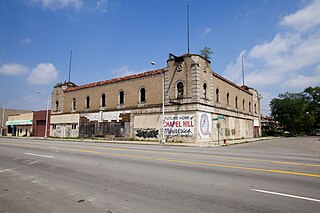
The Grande Ballroom is a historic live music venue located at 8952 Grand River Avenue in the Petosky-Otsego neighborhood of Detroit, Michigan. The building was designed by Detroit engineer and architect Charles N. Agree in 1928 and originally served as a multi-purpose building, hosting retail business on the first floor and a large dance hall upstairs. During this period the Grande was renowned for its outstanding hardwood dance floor which took up most of the second floor.
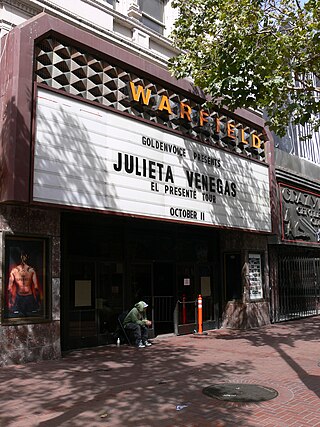
The Warfield Theatre, colloquially referred to as The Warfield, is a 2,300-seat music venue located in the Theatre District in downtown San Francisco, California, United States. It was built as a vaudeville theater and opened as the Loews Warfield on May 13, 1922.

The William Westerfeld House, also known as the "Russian Embassy", is a historic building located at 1198 Fulton Street in San Francisco, California, United States, across the street from the northwest corner of Alamo Square. Constructed for German-born confectioner William Westerfeld in 1889, the home is listed on the National Register of Historic Places and is San Francisco Landmark Number 135.

The Acid Tests were a series of parties held by author Ken Kesey primarily in the San Francisco Bay Area during the mid-1960s, centered on the use of and advocacy for the psychedelic drug LSD, commonly known as "acid". LSD was not made illegal in California until October 6, 1966.
The Maritime Hall is a historic 3,000-capacity concert hall in San Francisco's South of Market neighborhood that operated from 1995 through 2001 as a popular music venue and nightclub. It was located at 450 Harrison Street at the Sailors Union of the Pacific building.
The hippie subculture began its development as a youth movement in the United States during the early 1960s and then developed around the world.
The Boarding House was a music and comedy nightclub, located at 960 Bush Street in San Francisco, California, opened by David Allen in 1971 and closed in the early 1980s. Many comedians launched their career at the boarding house including Robin Williams. Steve Martin's first three albums were recorded there, Let's Get Small, A Wild and Crazy Guy, and Comedy Is Not Pretty!, in whole or in part. Ellen DeGeneres and Jay Leno have said they first met at The Boarding House.

The Mantra-Rock Dance was a counterculture music event held on January 29, 1967, at the Avalon Ballroom in San Francisco. It was organized by followers of the International Society for Krishna Consciousness (ISKCON) as an opportunity for its founder, A. C. Bhaktivedanta Swami Prabhupada, to address a wider public. It was also a promotional and fundraising effort for their first center on the West Coast of the United States.

Malati Dasi is a senior spiritual leader of the International Society for Krishna Consciousness (ISKCON). Born in Vallejo, California, she was part of the hippie movement before becoming an initiated disciple of A. C. Bhaktivedanta Swami Prabhupada in 1967. In the same year, she and her husband, Shyamasundar Das, helped Mukunda Das organize the Mantra-Rock Dance, a countercultural musical event held at the Avalon Ballroom in San Francisco; the dance was a fundraiser for ISKCON's first center on the west coast of the US.

The Scottish Rites Bodies Regency Center is a multi-use events venue located in San Francisco. at the intersection of Van Ness Avenue and Sutter Street. It opened in 1909 as a masonic lodge. In later years, it has served as a dance studio and movie theatre.

Alfred Henry Jacobs was an American architect. He designed theaters, hotels, residential, and religious buildings, primarily working in the San Francisco Bay Area. Three of the buildings he designed are listed on the National Register of Historic Places. He also worked as a watercolorist.
